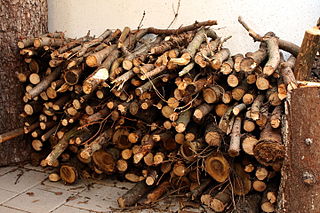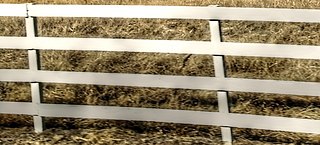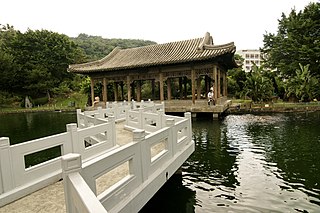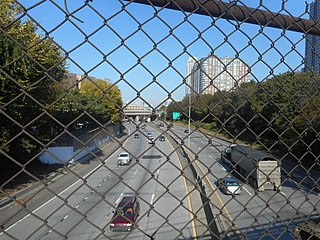
A fence is a structure that encloses an area, typically outdoors, and is usually constructed from posts that are connected by boards, wire, rails or netting. A fence differs from a wall in not having a solid foundation along its whole length.

Barbed wire, also known as barb wire, is a type of steel fencing wire constructed with sharp edges or points arranged at intervals along the strands. Its primary use is the construction of inexpensive fences, and it is also used as a security measure atop walls surrounding property. As a wire obstacle, it is a major feature of the fortifications in trench warfare.

In agriculture, fences are used to keep animals in or out of an area. They can be made from a wide variety of materials, depending on terrain, location and animals to be confined. Most agricultural fencing averages about 4 feet (1.2 m) high, and in some places, the height and construction of fences designed to hold livestock is mandated by law.

Firewood is any wooden material that is gathered and used for fuel. Generally, firewood is not heavily processed and is in some sort of recognizable log or branch form, compared to other forms of wood fuel like pellets. Firewood can be seasoned and heat treated (dry) or unseasoned (fresh/wet). It is generally classified as either hardwood or softwood.

A railway zig zag or switchback is a railway operation in which a train is required to switch its direction of travel in order to continue its journey. While this may be required purely from an operations standpoint, it is also ideal for climbing steep gradients with minimal need for tunnels and heavy earthworks. For a short distance, the direction of travel is reversed, before the original direction is resumed. Some switchbacks do not come in pairs, and the train may then need to travel backwards for a considerable distance.

A zigzag transformer winding is a special-purpose transformer winding with a zigzag or "interconnected star" connection, such that each output is the vector sum of two (2) phases offset by 120°. It is used as a grounding transformer, creating a missing neutral connection from an ungrounded 3-phase system to permit the grounding of that neutral to an earth reference point; to perform harmonic mitigation, as they can suppress triplet harmonic currents; to supply 3-phase power as an autotransformer ; and to supply non-standard, phase-shifted, 3-phase power.

The rail fence cipher is a classical type of transposition cipher. It derives its name from the manner in which encryption is performed, in analogy to a fence built with horizontal rails.

In woodworking, a saw-horse or sawhorse is a trestle structure used to support a board or plank for sawing. A pair of sawhorses can support a plank, forming a scaffold. In certain circles, it is also known as a mule and a short sawhorse is known as a pony. The names come from the shape of the frame, which resembles a horse. A sawhorse may also be a rack for supporting logs for sawing, known in the US as a sawbuck.
Zigzag is a jagged, regular pattern.

A zig-zag bridge is a pedestrian bridge composed of short segments, each set at an angle relative to its neighbors and usually with an alternating right and left turn required when traveling across the bridge. It is used in standard crossings for structural stability; and in traditional and contemporary Asian and Western landscape design across water gardens.

ZigZag is a data model, invented by Ted Nelson, that deconstructs the spreadsheet to allow irregular relations, at the same time generalizing the idea to multiple dimensions.

A chain-link fence is a type of woven fence usually made from galvanized or linear low-density polyethylene-coated steel wire. The wires run vertically and are bent into a zigzag pattern so that each "zig" hooks with the wire immediately on one side and each "zag" with the wire immediately on the other. This forms the characteristic diamond pattern seen in this type of fence.

John Whitton, an Anglo–Australian railway engineer, was the Engineer-in-Charge for the New South Wales Government Railways, serving between 1856 and 1890, considered the Father of New South Wales Railways. Under his supervision, it is estimated that 2,171 miles (3,494 km) of railway around New South Wales and Victoria were completed. Whitton was responsible for the construction of parts of the Main Western railway line, in particular the section over the Blue Mountains and the Lithgow Zig Zag, and much of the Main Southern railway line.
The Lincoln Trail Homestead State Park and Memorial is a 162-acre (66 ha) state park located on the Sangamon River in Macon County near Harristown, Illinois, United States.
Various obstacles are found in competitive sports involving horse jumping. These include show jumping, hunter, and the cross-country phase of the equestrian discipline of eventing. The size and type of obstacles vary depending on the course and the level of the horse and rider, but all horses must successfully negotiate these obstacles in order to complete a competition. Fences used in hunter and eventing are generally made to look relatively rustic and natural.

The Lumberjack World Championships are held annually in Hayward, Wisconsin. The event began in 1960 and is held at the Lumberjack Bowl. There are 21 events for both men and women to compete for over $50,000 in prize money. Contestants come from the United States, Canada, Australia, and New Zealand. The events include sawing, chopping, logrolling, and climbing to test the strength and agility of over 100 competitors.

The roundpole fence is a wooden fence typical to the countryside in Sweden, Norway, Finland and Estonia. It is normally made from unbarked and unsplit youngish trees, mostly spruce or juniper. Roundpole fences have traditionally been used as a means of fencing off animals rather than marking property boundaries.

Baulk road is the name given to a type of railway track or 'rail road' that is formed using rails carried on continuous timber bearings, as opposed to the more familiar 'cross-sleeper' track that uses closely spaced sleepers or ties to give intermittent support to stronger rails.
In graph theory, the zig-zag product of regular graphs , denoted by , is a binary operation which takes a large graph and a small graph and produces a graph that approximately inherits the size of the large one but the degree of the small one. An important property of the zig-zag product is that if is a good expander, then the expansion of the resulting graph is only slightly worse than the expansion of .

A synthetic fence, plastic fence or (when made of vinyl) vinyl or PVC fence is a fence made using synthetic plastics, such as vinyl (PVC), polypropylene, nylon, polythene (polyethylene) ASA, or from various recycled plastics. Composites of two or more plastics can also be used to increase strength and UV stability of a fence. Synthetic fencing was first introduced to the agricultural industry in the 1980s as low-cost, durable horse fencing. Now, synthetic fencing is used for agricultural fencing, horse race track running rail, and residential use. Synthetic fencing is generally available preformed, in a wide variety of styles. It tends to be easy to clean, resists weathering and has low maintenance requirements. However, it also can be more expensive than comparable materials, and cheaper products can be less sturdy than more traditional fence materials. Some types may become brittle, faded or degrade in quality after long exposure to extreme hot or cold conditions. Recently, titanium dioxide (TiO2) and other UV stabilisers have proven to be a beneficial additives in the manufacturing process of vinyl. This has greatly improved the durability of vinyl by providing essential UV protection from the sun's harmful rays, preventing premature ageing and cracking of the product, making it more durable than other materials such as wood.



















